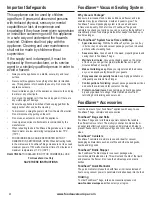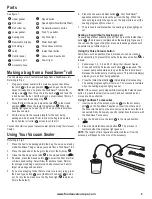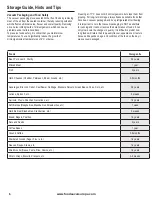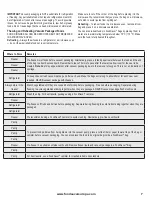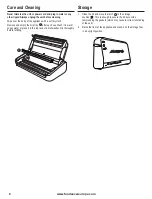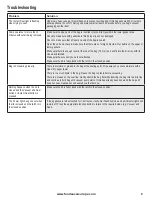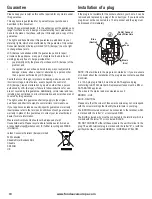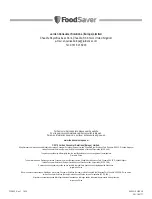
www.foodsavereurope.com
5
Parts
See figure 1
A
Upper gasket
L
Speed button
B
Roll cutter
M
Speed lights (Slow/Normal/Fast)
C
Roll cutter bar
N
Canister/Accessory button
D
Lower gasket
O
Food Type button
E
Sealing strip
P
Dry Food light
F
Removable drip tray
Q
Moist Food light
G
Roll storage
R
Pulse Vacuum button
H
Latch
S
Instant Seal button
I
Control panel
T
Vacuum and Seal button
J
Accessory port
U
Power light
K
Accessory hose
Making a bag from a FoodSaver
®
roll
You can make your own custom sized bags from a FoodSaver
®
roll.
Referring to Fig. 2:
1. Plug your vacuum sealer in to a mains supply socket. Move
the latch
H
to the open position (
) and open the lid. If you
haven’t already done so, place the FoodSaver
®
roll into the
storage area
G
then lift up the roll cutter bar
C
and feed the
roll end under the bar. Pull the roll end out until about 10mm of
the roll overlaps the sealing strip
E
.
2. Close the lid all the way and move the latch
H
to the closed
position (
). Press the Instant Seal button
S
. When the
sealing light goes out, open the lid. The end of the roll will now
have been sealed.
3. Pull the roll out to the required length for the item being
packaged. Add an extra 75mm to allow the bag to be sealed
then slide the roll cutter
B
across to cut the roll.
You can then start to use your vacuum sealer (refer to
Using Your Vacuum
Sealer
).
Using Your Vacuum Sealer
Referring to Fig. 3:
1. Place the item to be packaged into the bag. You can use a ready
made FoodSaver
®
bag or make your own from a FoodSaver
®
roll.
2. Place the open end of the bag into the slot of the drip tray
F
.
3. Close the lid and move the latch
H
to the closed position (
).
4. If desired, press the Speed button
L
to select the Fast, Normal
or Slow speed setting. Select Slow for delicate foods; Normal
for average sized bags, canisters and all accessories; Fast for
larger sized bags and canisters.
5. If you are packaging foods that are moist or are very juicy, press
the Food Type button
O
once (the Moist Food light
Q
comes
on). For dry foods, make sure the Dry Food light
P
remains on
(this is the default).
6. Press the Vacuum and Seal button
T
. Your FoodSaver
®
appliance
will start to remove the air from the bag. When the
vacuum progress light has gone out, the bag starts to seal (the
sealing progress light comes on).
7. The process is complete when the sealing progress light goes
out.
Sealing a bag without removing any air
To seal a bag without extracting the air from it press the Instant Seal
button
S
(the process is complete when the sealing light goes out).
You can seal the types of bag that are used to package snacks such
as potato crisps, tortilla chips, etc.
Using the Pulse Vacuum button
Some items such as pastries, bread, biscuits, etc. can be crushed
when vacuuming. To prevent this use the Pulse Vacuum button
R
as
follows:
1. Follow steps 1, 2, 3, 4 and 5 of
Using Your Vacuum Sealer.
2. Press and hold the Pulse Vacuum button
R
as required. The
vacuum pump will operate as long as the button is held down.
Release the button before crushing occurs. This will immediately
stop any more air from being extracted.
3. Press the Instant Seal button
S
immediately after vacuuming.
The sealing progress light will come on. The process is complete
when the sealing progress light goes out.
NOTE: If the vacuum pump stops while pressing the Pulse Vacuum
button, it means the maximum vacuum has been reached and no
more air can be extracted.
Using FoodSaver
®
accessories
1. Insert one end of the accessory hose
K
into the accessory
port
J
on the FoodSaver
®
appliance. Insert the other end of
the hose into the port on the accessory and make sure that it is
connected firmly. Follow any specific instructions that come with
the FoodSaver
®
accessory.
2. Close the lid and move the latch
H
to the closed position
(
).
3. Press the Canister/Accessory button
N
. The process is
complete when the progress light goes out.
NOTE: The length of time required to extract all the air from the
accessory will depend on the size of the accessory.




